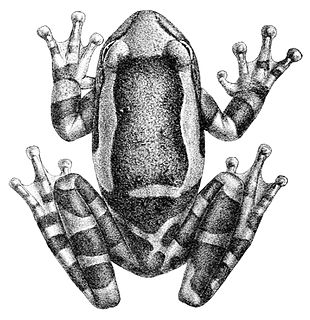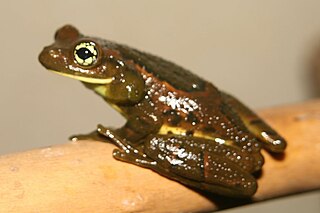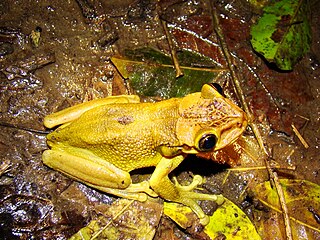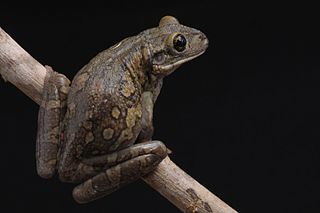
Hylidae is a wide-ranging family of frogs commonly referred to as "tree frogs and their allies". However, the hylids include a diversity of frog species, many of which do not live in trees, but are terrestrial or semiaquatic.

Trachycephalus is a genus of frogs, commonly known as the casque-headed tree frogs, in the family Hylidae. They are found in Mexico, Central America, and South America. In a recent revision, the seven species of the genus Phrynohyas were included in this genus, and Phrynohyas is now considered a synonym of Trachycephalus. These frogs inhabit the canopies of tropical rainforests, where they breed in tree cavities, and seldom, if ever, descend to the ground.

The Mission golden-eyed tree frog or Amazon milk frog is a large species of arboreal frog native to the Amazon Rainforest in South America. It is sometimes referred to as the blue milk frog. It was first discovered along the Maracanã River in Brazil. This species was previously within the genus Phrynohyas, which was recently synonymized with Trachycephalus.
Trachycephalus venezolanus is a species of frog in the family Hylidae. It is found in Brazil, Colombia, and Venezuela. Its natural habitats are subtropical or tropical moist lowland forests, subtropical or tropical swamps, intermittent freshwater lakes, and freshwater marshes. It is threatened by habitat loss.
Bokermann's casque-headed tree frog is a species of frog in the family Hylidae endemic to Brazil. Its natural habitats are subtropical or tropical dry forests, moist savanna, subtropical or tropical dry shrubland, and intermittent freshwater marshes. It is threatened by habitat loss.

The Surinam golden-eyed tree frog is a species of frog in the family Hylidae found in Bolivia, Brazil, Ecuador, French Guiana, Peru, Suriname, and possibly Colombia. Its natural habitat is subtropical or tropical moist lowland forests. It is threatened by habitat loss.

The New River tree frog is a species of frog in the family Hylidae found in French Guiana, Guyana, Suriname, and possibly Brazil. Its natural habitat is subtropical or tropical moist lowland forests.

The Rio golden-eyed tree frog is a species of frog in the family Hylidae found in Argentina and Brazil. Its natural habitats are subtropical or tropical moist lowland forests, subtropical or tropical moist montane forests, and freshwater marshes. It is threatened by habitat loss.

Jordan's casque-headed tree frog is a species of frog in the family Hylidae found in Colombia, Ecuador, and Peru. Its natural habitats are subtropical or tropical dry forests, subtropical or tropical moist lowland forests, intermittent freshwater marshes, plantations, rural gardens, urban areas, and heavily degraded former forests. It is threatened by habitat loss.
Trachycephalus lepidus is a species of frogs in the family Hylidae endemic to Brazil. Its natural habitat is subtropical or tropical moist lowland forests. It is threatened by habitat loss. This species was previously within the genus Phrynohyas, which was recently synonymized with Trachycephalus.

Trachycephalus mesophaeus is a species of frog in the family Hylidae. It is endemic to eastern Brazil and occurs in the Atlantic Forest between Pernambuco and Rio Grande do Sul, extending inland to central Minas Gerais. It is found at elevations below 800 m (2,600 ft). Common name Porto Alegre golden-eyed treefrog has been coined for it, Porto Alegre being its type locality.

The black-spotted casque-headed tree frog is a species of frog in the family Hylidae endemic to Brazil. Its natural habitats are subtropical or tropical moist lowland forests, subtropical or tropical moist shrubland, freshwater lakes, intermittent freshwater lakes, freshwater marshes, intermittent freshwater marshes, rural gardens, and heavily degraded former forests. It is threatened by habitat loss.

The veined tree frog, or common milk frog, is a species of frog in the family Hylidae. This species was previously within the genus Phrynohyas, which was recently synonymized with Trachycephalus . It is found in Central and South America. Its natural habitats are subtropical or tropical dry forest, subtropical or tropical moist lowland forest, subtropical or tropical moist shrubland, subtropical or tropical dry lowland grassland, rivers, intermittent rivers, freshwater lakes, freshwater marshes, intermittent freshwater marshes, arable land, pastureland, plantations, rural gardens, urban areas, heavily degraded former forest, water storage areas, and ponds. The veined tree frog is nocturnal, and can typically be found in tree branches and in areas with large amounts of vegetation. This frog is one of several other tree frogs in the family Hylidae that secrete a toxic substance from their skin that produces extreme irritation and pain when in contact with mucosal membrane surfaces.
Stenocercus trachycephalus, Duméril's whorltail iguana, is a species of lizard of the Tropiduridae family. It is found in Colombia.
Trachycephalus quadrangulum, the Chocoan milk frog, is a species of frog in the family Hylidae. It is endemic to the Pacific slopes of the Andes in Ecuador and Peru. Scientists have seen it between 20 and 350 meters above sea level.
Trachycephalus macrotis, also known as the Amazonian milk frog and known in Spanish as rana lechera de Pastaza, is a frog in the family Hylidae. It is endemic to Peru and Ecuador. Scientists have seen it between 225 and 925 m above sea level.

Trachycephalus dibernardoi is a frog in the family Hylidae. It is endemic to Brazil and Argentina. Scientists think it might also live in Paraguay.
Trachycephalus heloi is a frog in the family Hylidae. Scientists have only seen it in one place, in Brazil.
Trachycephalus cunauaru is a frog in the family Hylidae. It is endemic to Brazil, Bolivia, and Ecuador, where it lives in rainforest and other forest habitats. Scientists believe it may also live in Colombia and Peru. Scientists have seen it as high as 800 meters above sea level.
Tepuihyla shushupe is a frog in the family Hylidae. Scientists know it exclusively from the site of collection: The headwaters of the rivers Ere and Campuya near the Colombia border within Peru. They collected the sample 145 meters above sea level.










